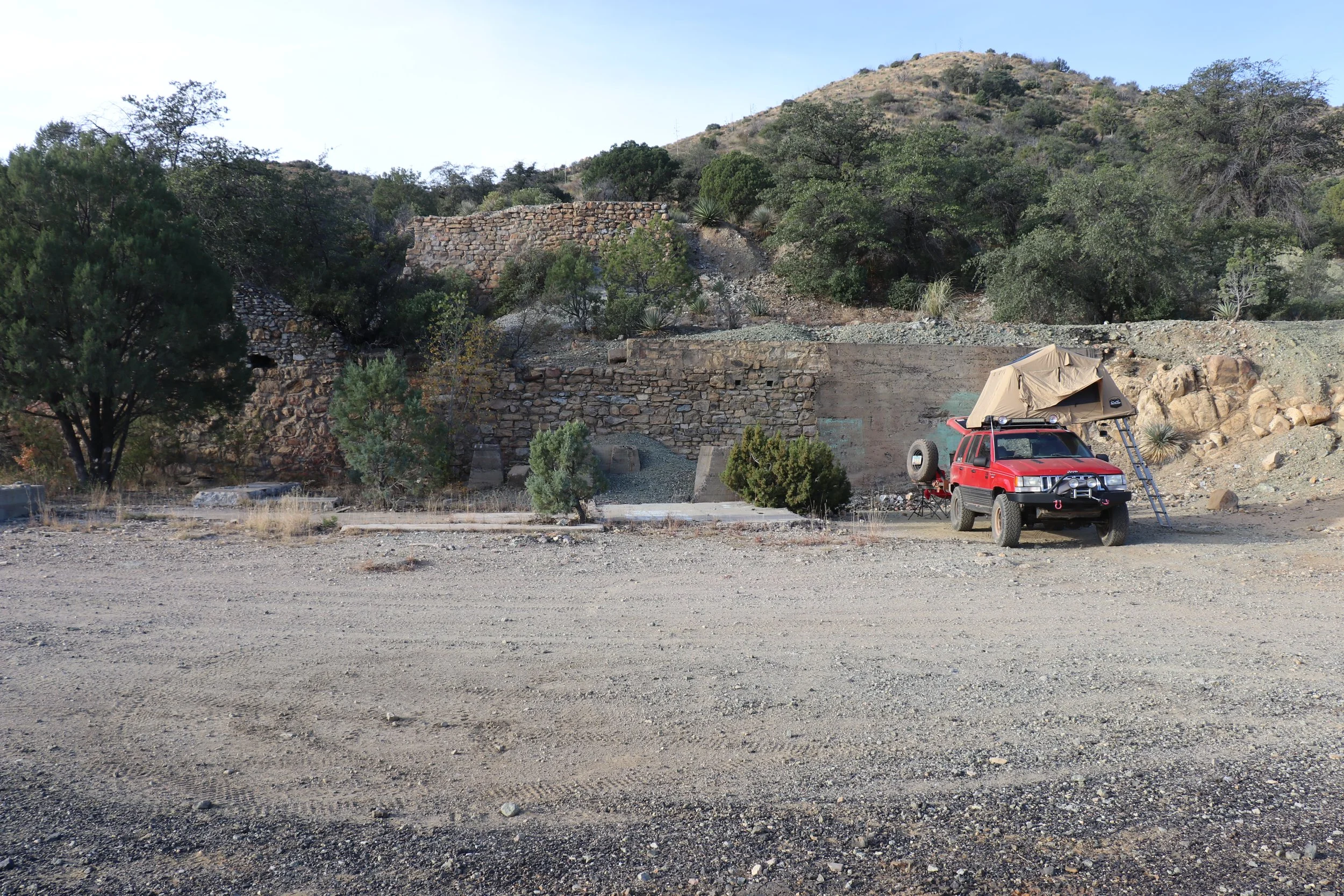Cochise County
Middlemarch Mine
Tucked away in a secluded canyon, this former copper operation was worked from 1895 to the 1980s
The Middlemarch Mine is a small to medium sized copper operation located in a remote canyon in the Dragoon Mountains between Tombstone and Pearce. First worked in the mid-1890s, the property would be shut down intermittently until the 1980s. Low grade ore, lack of water, and difficulty transporting the ore would ultimately lead to its downfall, but several foundations and an adit remain on site today.
The Middlemarch Mine appears to have been first discovered in 1895 and prospected by Chinese merchants from Tombstone. The operation was backed financially by businessmen in San Francisco. First called the Missouri Mine, the operation really didn’t take off until about 1899 or 1900 when Richard Gird (a businessman who also worked the Millville operation) took over the property. A small water jacket furnace was operated until a small concentrating plant was soon built on site to process the ore. However, much of the low-grade ore found near the surface proved difficult to smelt and refine using the available methods. Due to the lack of success, about 70 additional carloads of ore were shipped to a smelter in Douglas, but mostly at a loss.
Inside the partially flooded main adit and haulage tunnel at the Middlemarch mine.
In the early part of 1917, the property was taken over by the Arizona Middlemarch Copper Company. During this time, the mine was backed by Los Angeles businessmen who operated 43 claims at the Middlemarch, in addition to other nearby claims. A flotation mill was built on site, with a daily capacity of processing 125 tons. This milling setup was more advanced than prior attempts, and included a bucket elevator, ore bins, ball mill, and even tailing ponds. This allowed better extraction of copper, silver, gold, and zinc although ore values remained relatively low grade. At its peak, the Middlemarch employed about 20 men, and had 12 buildings on site – including a large mill building, 300 horsepower steam plant, boiler house, and machine shop.
The property had 9 shafts, 6 tunnels, and eventually up to 3 ½ miles of underground tunnels. By 1919, 51 car loads of ore concentrate had been shipped and by 1921, about 300 total cars had been shipped. The ore was hauled 9 miles back out to the railhead in Pearce, then south to the Copper Queen Smelter for further refinement. The mill at Middlemarch shut down in September of 1920 due to water shortages, and the property sat idle from 1921 to 1924. Water played a vital role in the refinement of ore. The flotation mill was a water-intensive process as the tailing ponds would be filled, and slowly drained and dried out over a 2 week process. By 1942, the property was still idle.
Assessment work and new owners completed mining on the property most notably in the 1950s, and more successfully in the 1970s and 80s. During this time, the leaching ponds were revamped and expanded, plastic piping was added to the mine to clear it out, and an open pit area further developed. Estimates claimed that 200,000 tons of ore was readily available underground, and the value of the ore was worth “well over 6 billion dollars”. However, legal issues with the title and property owners slowed any chance of new development to a halt. It appears that after the 1980s, no further serious work was done, and the Middlemarch has been abandoned since.
Most of the foundations are near the milling area, where ore would have been processed.
Many of the original foundational structures appear to remain today. The multiple levels of the mill operation are the most notable. These were likely built sometime after 1917 when a new mill was constructed. Ore would have moved downhill, going through a variety of steps to refine it into a more transportable and valuable product. According to a grainy old newspaper photo, it seems like an impressive wooden framed structure was built over the milling area at one point.
A small concrete pad and an adit remain just uphill of the main ruins. The opening was well camouflaged in the terrain, with some overgrowth and collapse in front of it. A combination of wood timbering and corrugated metal made up the entrance – which seemed relatively stable. Further inside, some kind of wooden ladder or track, as well as some more modern plastic piping lay on the floor. This was probably used to pump out water into the leaching operation in the 70s and 80s. The bottom was flooded with water at least a few inches deep.
A few more structures lay further away from the adit. An earthen dam structure and a small pit, lined with cinder blocks and a concrete ramp also remained. This was likely part of the later refining process, as it seems to be made of more modern materials. Back at the lowest levels of the mine, discolored rock remains in the old tailing ponds. It seems a considerable amount of material came out of this and other mines in the area. The tailing pile is topped with solid slag, which is made up of metals and other impurities that weren’t desired.
Sources:
Arizona Department of Mining & Mineral Resources. “Middlemarch Mine File (resource ID: 2011-01-2531)” - MiddlemarchmineCochise102.pdf. Tucson, AZ: Arizona Geological Survey (AZGS). PDF. http://docs.azgs.az.gov/OnlineAccessMineFiles/M-R/MiddlemarchmineCochise102.pdf
Cambior Exploration USA Inc. records. “Middlemarch Mining Property (resource ID: 1999-01-0036)” - 1999-01-0036.pdf. Tucson, AZ: Arizona Geological Survey (AZGS). PDF. http://docs.azgs.az.gov/SpecColl/1999-01/1999-01-0036.pdf
Walter E. Heinrichs, Jr. mining collection. “Middlemarch Property File (resource ID: 2002-01-0083)” - 2002-01-0083.pdf. Tucson, AZ: Arizona Geological Survey (AZGS). PDF.http://docs.azgs.az.gov/SpecColl/2002-01/2002-01-0083.pdf

















